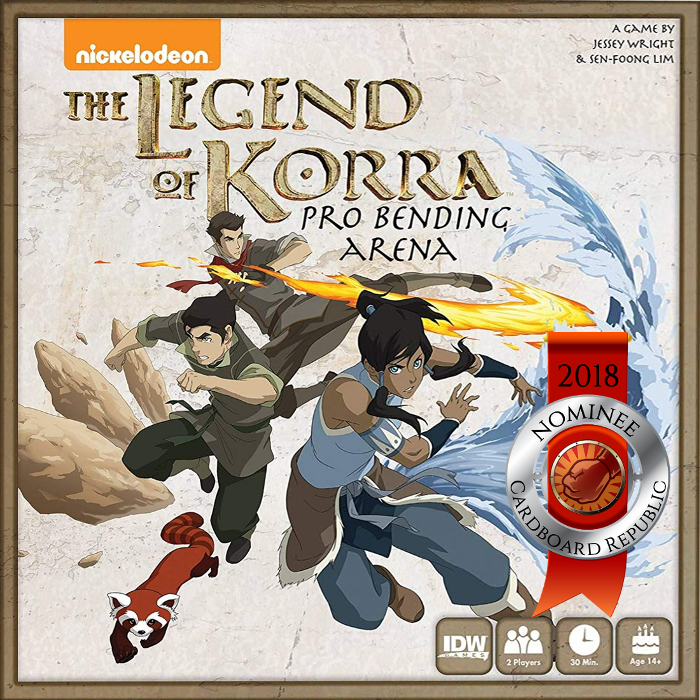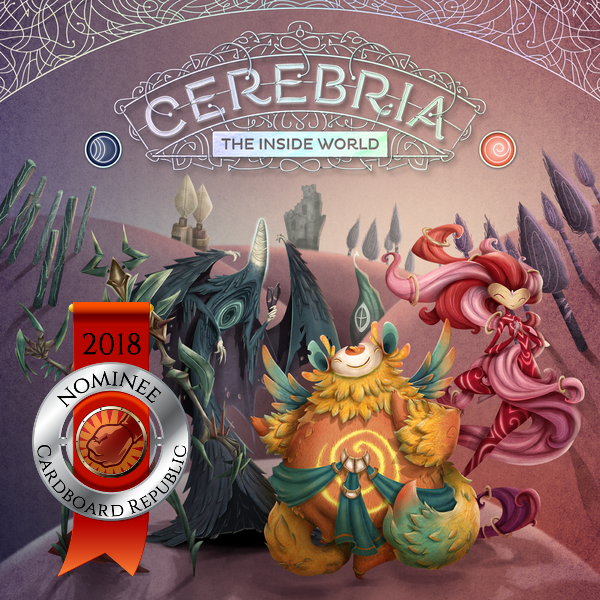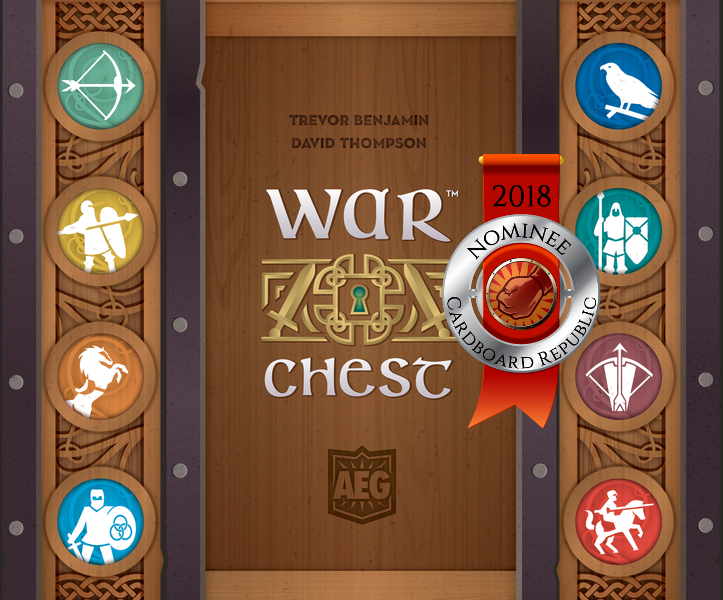The Cardboard Republic has rolled out the annual Laurels of the Republic awards, celebrating the best new games released in 2018 for each of the gamer archetypes. What follows are the finalists for one of those groups.
 Always looking for the next conflict, Strikers are those who prefer to make bold, declarative statements in their games. Their ambitions are simple: win by any means necessary, and do it quickly if possible. Strikers thrive in games where there are clear goals and the player’s chances of a particular strategy isn’t going to completely fall apart due to high degrees of luck or overly-lengthy affairs where their opponents will have ample opportunities to stop them. In short, the best Striker games are those where they are given a pointy stick and told in which direction to swing it.
Always looking for the next conflict, Strikers are those who prefer to make bold, declarative statements in their games. Their ambitions are simple: win by any means necessary, and do it quickly if possible. Strikers thrive in games where there are clear goals and the player’s chances of a particular strategy isn’t going to completely fall apart due to high degrees of luck or overly-lengthy affairs where their opponents will have ample opportunities to stop them. In short, the best Striker games are those where they are given a pointy stick and told in which direction to swing it.
And with that, here are The 2018 Laurel Finalists for Strikers:
Honorable Mention: Wildlands
Publisher: Osprey Games | Players: 2-4 | Play Time: 30-60 Minutes
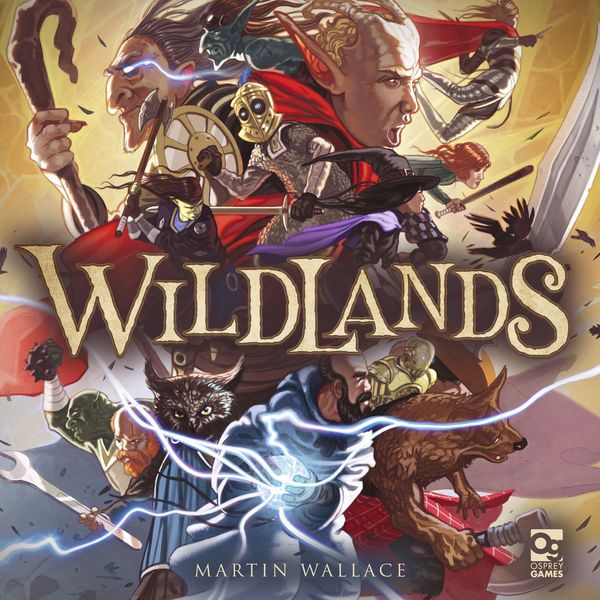
Once upon a time there was a great and powerful place/people/civilization. And then the Big Bad Person/People/Things showed up and the great and powerful place/people/civilization, in a last desperate act, sacrificed themselves to save the world with the help of some kind of magical/technological MacGuffin. This story picks up after that point, in a land of ruins and legends, where life is grittier, more difficult, and a whole lot more complicated.
This is a fairly common story framework, and odds are you can name at least one book, TV show, or movie that follows that premise. It is also the same pastiche applied to the game Wildlands. But, as is often the case, it’s a trope that also works.
In this game, which takes place in a post-cataclysm world, players control a team of five units, each with their own ambitions and agendas as they scour the land trying to recover precious crystal shards. Each turn, you play character cards that allows your units to move, attack, claim crystal shards, or perform special maneuvers. You can play as many cards each turn as you want, but careful hand management is essential as cards can also be used for defense and you only draw a few each turn. Every time a shard is captured or an opponent knocked out, you get a point; the first to five wins.
Wildlands is, essentially, a cardboard-based arena-style deathmatch game with fantasy trappings, mixing both capture the flag and team elimination elements into one short, well-produced, card-driven test of tactical supremacy. Driven almost entirely by some pre-match planning and player decisions thereafter, Wildlands is a visually and mechanically appealing game solely about making the most advantageous moves that get you closer to your objective. Which is about as straightforward as it comes.
Because of this, Wildlands is deserving of the honorable spot for Strikers. With unique faction strengths and weaknesses, hidden starting locations, excellent components, and clear, concise rules, Wildlands makes for a quick and often brutal game of opportunism as 2-4 players scramble to get to five points by any means necessary.
The Nominees

Number Five: The Legend of Korra: Pro-Bending Arena
Publisher: IDW Games | Players: 2 | Play Time: 30-45 Minutes
Water. Earth. Fire. Air. Only the Avatar can master all four elements and bring balance to the world…
Luckily for you, you are neither the Avatar, nor does this game require you mastering any of the elements. In fact, no prior knowledge of The Legend of Korra or Avatar is even necessary to appreciate what this arena fighting game has to offer.
(Also, if you haven’t checked out either of those shows, do yourself a favor and track them down. They’re two of the best animated shows around.)
The Legend of Korra: Pro-Bending Arena reflects the in-world competitive sport known as Pro Bending, in which two teams of three characters square off with the intent of either knocking their opponents out of the ring or advancing furthest onto your opponent’s side of the board when time is called. Each team is composed of three ‘benders’ – people who have the innate ability to control a basic element of water, earth, or fire. Turns consist of playing three cards containing various combinations of movement, blocks, attacks, and special effects, and the optional choice over the course of the game to upgrade the efficacy of your benders with better cards. Attacks add elemental tokens to spaces; should you ever end your turn with an opponent’s token(s), your bender is thrown backwards, possibly even outside the ring.
Much like the martial arts styles that inspire a bender’s moves, Pro-Bending Arena is a veritable high stakes dance of power and consequence. With only a few cards to play a turn and little room for error, every turn forces you to tactfully maneuver about the board, dodge attacks, try to set traps and land blows, and generally strive to keep your opponent on their heels. The game’s back-and-forth combat and straightforward-yet-weighty tactical choices ensures a captivating event as tensions mount and the bout builds towards conclusion. And, much like most sporting events, the outcome is largely driven by the skills of the players themselves. Surviving in the Pro-Bending League requires quick thinking, adaptability, and never losing track of its singular goal: to win. Which is precisely the kind of game that Strikers bend their attention towards.
Number Four: Cerebria: The Inside World
Publisher: Mindclash Games | Players: 1-4 | Play Time: 60-120 Minutes
Cerebria, the latest product of the fittingly-named Mindclash Games team, is easily the longest and most complicated of this group’s nominees. It also happens to have the most creative, if not down right esoteric concept of the lot. And while that alone doesn’t mean much to Strikers, the fact that this game is almost entirely about player-driven conflict and objective-based victory conditions certainly will.
Basically, this game is like the movie Inside Out…if it had been written by Neil Gaiman.
Cerebria takes place inside the world of a budding consciousness, in which two sides are trying to influence its growth as much as possible. Leaning heavily into its unique concept, one team represents positive emotions such as love and joy, while the other commands negative emotions such as envy and jealousy, all of which is conveyed with stunning visuals. Over the span of the game, which can be played 1 on 1 or in teams, you are constantly striving to maintain control of numerous regions on the board by deploying and strengthening emotion cards of your factions.
Rather than being a slugfest for mere territorial dominance, however, Cerebria takes a slightly more highbrow approach to area control. Victory here is achieved by fulfilling a rotating set of objectives – one shared and one hidden – during each of the game’s scoring rounds. The more goals you accomplish, the closer your side is to victory. In this, each game of Cerebria is more like a series of individual skirmishes than one massive battle, which is very much in a Striker’s wheelhouse.
Beneath its beautiful aesthetics and ample flavor, Cerebria’s gives players much to think about as they navigate their way through this mindful maze of power and clashing factions. Much of the game’s success is about optimizing your limited time and resources as you pivot from one task to the next and rewarding you for your efforts. From emotion and action upgrades to ruling territory, to even deciding when to trigger scoring, Cerebria provides ample governance over your own inner destiny and where luck only plays a minor role. All of which is bound to make this group pretty emotional.
Number Three: KeyForge: Call of the Archons
Publisher: Fantasy Flight Games / Asmodee North America | Players: 2| Play Time: 30-45 Minutes
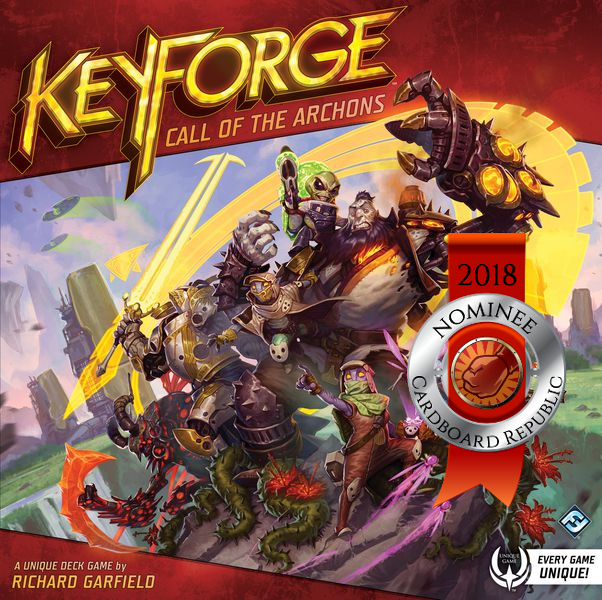 When KeyForge made its surprise debut at Gen Con 2018, it was met with equal parts excitement and confusion. On the one hand, it was a new card game being unveiled by Fantasy Flight Games, home of numerous competitive card games such as Legends of the Five Rings, the Arkham Horror LCG, and Android: Netrunner (RIP). On the other hand, KeyForge was touted as a game with truly novel twist: not only are the decks in this head-to head style game not customizable, but every single deck is unique. Every. Single. One. Which was a mind-boggling, untested, and risky undertaking for any physical product to attempt.
When KeyForge made its surprise debut at Gen Con 2018, it was met with equal parts excitement and confusion. On the one hand, it was a new card game being unveiled by Fantasy Flight Games, home of numerous competitive card games such as Legends of the Five Rings, the Arkham Horror LCG, and Android: Netrunner (RIP). On the other hand, KeyForge was touted as a game with truly novel twist: not only are the decks in this head-to head style game not customizable, but every single deck is unique. Every. Single. One. Which was a mind-boggling, untested, and risky undertaking for any physical product to attempt.
The hobby writ large was intrigued by the buzz, and while immediate feedback was positive, there was still concern that this experiment either would be seen as too gimmicky or would fail to entice gamers to buy in to the concept. At the time, no one really knew what to expect.
Well, we now have that answer, with KeyForge generating massive attention and sales thanks to its ingenious idea of creating a vibrant and dynamic CCG-like game – minus the whole time consuming, deckbuilding, money-sinking parts.
In KeyForge, two players have their own deck as they face off as godlike Archons, trying to be the first to acquire enough energy to construct three Keys and win the game. Each deck in the game is randomly produced using a few dozen cards belonging to three of more than a dozen different factions, with turns mostly consisting of selecting a specific faction and then playing cards from said faction, including summoning creatures, casting spells, and dropping artifacts.
And if this sounds a bit Magic: the Gathering-y to you, you’re not crazy: both were at least partially designed by the very same Richard Garfield.
KeyForge quickly garnered a fairly accurate reputation as being Magic-esque in style thanks to tense duels where both players must balance tactical decision-making, strategically timed card plays, and a definitive goal to strive for, which just screams Striker game. It’s short, forceful, addictive, and it accomplishes all this without anywhere near the rules complexity or institutional baggage (not to mention cost) of its much older cousin.
Number Two: War Chest
Publisher: Alderac Entertainment Group | Players: 2/4 | Play Time: 30 Minutes
Of all the games on this group’s list, War Chest came with the least amount of initial fanfare, quietly releasing at Gen Con amongst a sea of cardboard competing for everyone’s attention. However, thanks to its brisk gameplay, concise ruleset, and clever mixing of traditional wargaming with bag building via poker chips, it swiftly gained much well-deserved aplomb among enfranchised and casual gamers alike.
It also doesn’t hurt that it’s packaged in the form of, well, a war chest.
Like many of its kind, War Chest is a battlefield simulation game. In this case, you are medieval generals trying to capture and hold various battlefield locations. In it, payers command stacks of 4 out of 16 different unit types, replete with their own special benefits. Which units you use each game can be determined randomly, via draft, or even in specific sets to recreate key historic battles from the days of yore, providing the game with an abundance of variability and deep replayability before the first war horn is even sounded.
Units in the game are depicted via poker chips, of which three are randomly drawn each round. Taking turns, you must decide how to best utilize that token, be it to move, attack, activate a special ability, or recruit more units into your chip pool. With a finite number of units at your disposal and only so much time to lock down six locations before your opponent succeeds at marshaling their forces to do the same, War Chest ensures battles that are quick, decisive, and almost universally based around its singular goal. In this game, there is neither the need for, nor capability of, anything other than the drive to stand victorious on the field of battle.
War Chest is the latest title in the long and storied genre of abstract games with specialized units, joining the likes of Chess, Hive, and The Duke, demonstrating that even abstract design concepts can find new ways of innovating in the modern era. While its outward appearance seems Spartan, its game flow and capacity for player-driven outcomes despite an element of randomness is nothing short of elegant. Both tactical and tactile, War Chest is a game tailor-made for Strikers in every conceivable way, making it something for them to easily rally behind.
War Chest certainly made an impact on quite a few people in a short period of time, and even had a potential shot at the top spot in this year’s list. However, it just so happened to run headlong into another game about trying to reign supreme on the battlefield. And that one has cats.
The Winner
2018 Striker Laurel – Root
Publisher: Leder Games | Players: 2-4 | Play Time: 60-90 Minutes
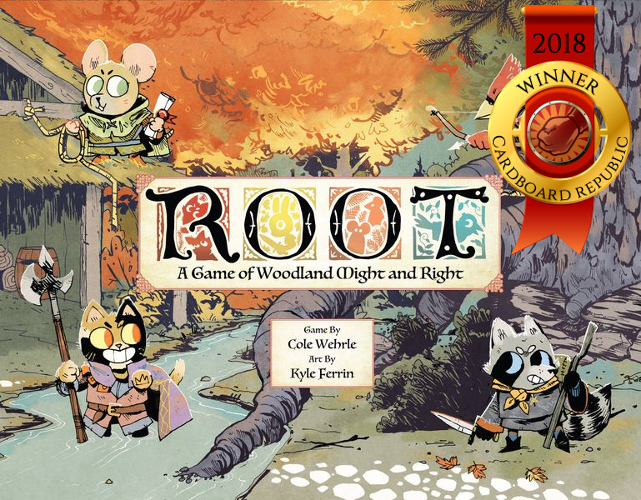 Of all the games in this year’s nominations, we were most confident about Root’s chances in the Striker category, and it only really takes one playthrough to fully understand why. Building upon the success of its predecessor Vast, Root emerged as a streamlined, more accessible iteration of asymmetric gameplay, this time based around the idea of territory control. This combination not only makes for a highly engaging contest as each faction strives to assert their presence on the board, but its unconventional approach nurtures a very different experience than your standard territory control game.
Of all the games in this year’s nominations, we were most confident about Root’s chances in the Striker category, and it only really takes one playthrough to fully understand why. Building upon the success of its predecessor Vast, Root emerged as a streamlined, more accessible iteration of asymmetric gameplay, this time based around the idea of territory control. This combination not only makes for a highly engaging contest as each faction strives to assert their presence on the board, but its unconventional approach nurtures a very different experience than your standard territory control game.
That Root also comes with wonderfully picturesque components and top-notch artwork certainly doesn’t hurt either.
At any rate, welcome to the dystopian version of the Hundred Acre Wood, where Christopher Robin has disappeared and things have gone horribly awry.
Root is asymmetric game in which each player controls a different faction trying to control the forest, each with their own powers, style of gameplay, and means to generate the 30 VP necessary to win. In this game of copses and corpses, players may choose between the industrialist Cats, who wish to turn the forest into factories and thrive by erecting buildings across the land; aristocratic Birds who long for the days of yore when they ruled the roost and must retake territory while adhering to programmed moves; the rebellious Woodland Alliance of forest dwellers rising up in favor of self-rule and who utilize guerilla tactics to undermine their enemies; and the secretive Vagabond Raccoon who wants to collect your extra pair of shoes for…well never you mind why. Players take turns moving around the board, attacking opponents and securing territory until one faction crosses the finish line.
Root’s primary appeal to Strikers resides in the fact that despite each faction carrying with them a distinct flavor and sense of purpose, everyone’s competing agendas ensures that conflict isn’t just encouraged as everyone squeaks, squawks and sneaks their way to victory – it’s required. Root is a game that’s interactive, competitive, and encourages you to advance your own agenda while still providing ample means to undermine your opponents from doing the same thing. It’s adorable, brutal, strategic, and deeply replayable. All of which is why this inventive and distinctive game has lumbered to this group’s top spot for 2018.
![]()
Root Contest!
When it came to figuring out how we wanted to show off this year’s Striker Laurel we initially came up with a rather adventurous way to champion the game’s competitive stakes for woodland dominance, which could have involved some blindfolds, a trip into the forest, and the unveiling of a massive capture-the-flag event. But it turns out using the words ‘forest’ and ‘blindfold’ in the initial pitch made certain potential sponsors a bit uneasy. Something something too Lord of the Flies meets Watership Down-y. Also, provisions for 100+ people add up in a hurry. Also also, it would have been at the height of mosquito season, and not even we are that cruel. So we dialed it back just a tad and have instead opted for the most direct approach: providing one lucky winner with the opportunity to enjoy the award-winning game first hand. That is what we’re going to to do right…now.
That’s right! Enter below for your chance at your very own copy of Root!
One Copy of Root
Note: In honor of their award recognition, Leder Games has kindly provided a copy of this game for giveaway purposes.
![]()
Be sure to check out the 2018 Laurel Award pages for the other archetypes once they go live!

